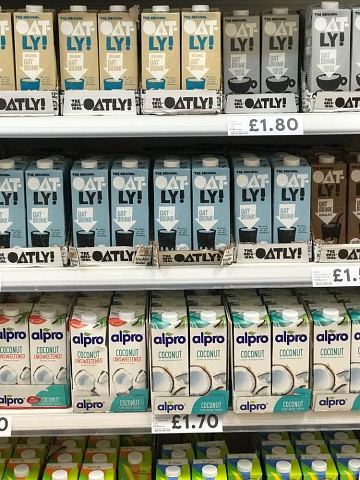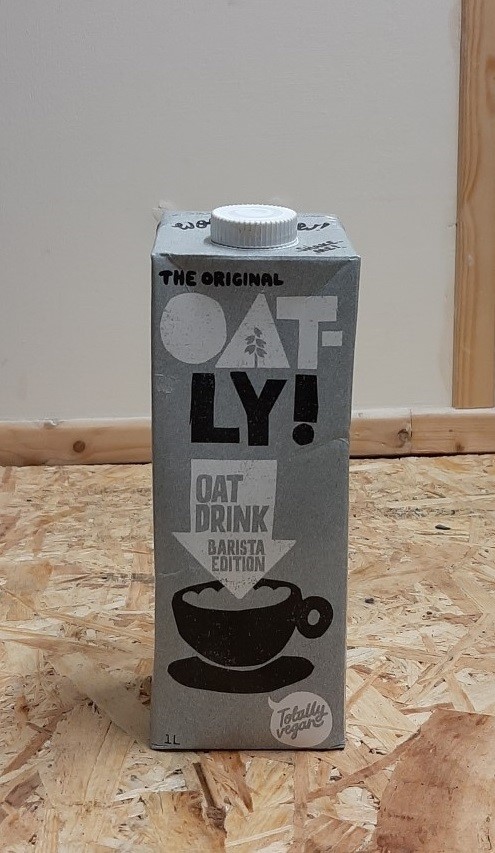A Breakdown of the best non-dairy white stuff options
14 February 2020 by Kia Tromans

Times are changing, and the amounts of alternatives to full fat diary milk being consumed are on the rise, whether these be plant based, lactose free, low fat or any dietary specific, diary milk alternatives are unarguably on the rise. Coffee shops, cafes and anywhere else that serve drinks like coffee, tea and milkshakes where milk plays a central roll in the creation of the drink need to keep up with the ins and outs of all the alternatives to milk if they want to be able to keep providing their patrons with the best service possible. We have previously posted a blog post that shows a graphic from a study into the popularity and use of different plant-based milks, so that is definitely worth checking out along with the following discussion.
Some non-dairy milks are easier to make coffees with than others, some have a stronger distinct taste to them, which may or may not be a good thing depending on each individual customer. With the number of alternatives that are gaining traction these days it can be difficult to keep track of, so we’re here today to try and make things slightly easier to understand.

The main aspects of milk alternatives that we think need to be focused on when deciding what type of alternative you may want to use are the taste of the alternative, how noticeable it is in a coffee and if it overpowers the taste of the drink for example, and whether or not it is easy to work with the milk for texturing and producing foam for drinks like flat whites and cappuccinos.
Oat Milk
Oat milk is one of the leading non-diary options for milk currently and has been in high favour for a while. It is a decent healthy alternative, containing less fat that most dairy milks whilst keeping a lot of the protein content, but also contains a good amount of fibre.
One of the main reasons it is one of the more popular non-diary options is because its taste is not dissimilar to that of full fat diary milk, and so for people leaving diary milk behind for either healthier options or a lifestyle change like becoming vegan, oat milk provides an alternative whilst still be familiar to the taste buds.
When it comes to foaming the milk for drinks, oat milk can be foamed, and barista blends are available to make this easier. It may require more steaming than diary milk to create a good level of foam, but it is doable without ruining the drink.
Soymilk
This is another one of the main non-diary options that has seen a lot of popularity over the years. Soymilk is an accessible and affordable alternative due to its popularity, and most people are more than likely familiar with it by now.
Speciality barista blends are available once again and are especially recommended for the option, as soymilk can have some issues with curdling or separating from coffee. This is said to be a reaction to the difference in temperature, so milk being foamed before use should not be an issue in any case, but if you are just pouring refrigerated soymilk into a cup of coffee this is something that needs to be taken into account and tested before serving to customers. Another reason that this can curdle in coffee is due to the acidity of the coffee, this is a tougher element to control as it will vary greatly on the coffee you personally use, so testing out is always recommended.
Most brands and blends of soymilk do not have such a strong taste that it is noticeably different in most drinks from milk, and the quality of some of the barista blends available can make this milk almost as easy to foam as full-fat diary options.
Coconut Milk
Coconut milk is different from the alternatives discussed so far due to the fact that its strong, distinct flavour, different from that of full-fat milk, is its main selling point. For people who like the flavour and are looking for a new, almost tropical, twist on their favourite drinks may find coconut milk to be a refreshing change. This does of course also mean that for people who do not like the taste, this is easily not the plant-based alternative to go with. Due to this, if you are going to stock this as an alternative, we do recommend having other non-dairy options available as to not leave out those who want a plant-based milk but do not like the taste of coconut.
For foaming this milk, some have said that they think it creates larger bubbles than diary milk but can also be less dense.
Almond Milk
Almond milk is another non-dairy option where you need to be aware that there is potential for it to curdle in coffee just like soymilk, and for the same reasons of temperature and acidity. Once again be careful when pouring this milk into a drink of vastly different temperature and try it out with your coffee blends to see if acidity will be an issue or not before taking this on as an option.
This milk has a lot of different varieties and flavours available, so trying out a few different blends, and sweetened and unsweetened versions, may be the key to finding the right balance of flavour to go with your coffee of choice.
Almond milk can be worked with to create good foam, but some have found that it is likely to separate from the coffee quick easy.
Hemp Milk
More and more products are being made with the use of hemp these days, and now milk made from hemp seeds is starting to gain some popularity. Whilst this does contain trace amounts of THC, the psychoactive element, it is nowhere near any level where people should be concerned about its effects. It’s high level of protein content might be one of the reasons why its gaining popularity, as a healthy alternative. It has a quite a distinct and perhaps acquired taste, so this is another option that we’d say don’t stock as your sole non-diary option, at risk of leaving out some people who have the dietary needs but do not like the flavour, some people have described it as being anywhere between a nutty, beany or earthy taste, it’s certainly interesting!
For how this milk is to work with, once again we recommend looking into barista specific version of this milk for a start, and because the milk is already high in protein, it is quite suitable for foaming.
Pea Milk
This is another alternative that is high in protein, making it a healthy option as well as a good option for foaming and texturing. Not only that but some people have also said that this is one of the best non-dairy options in terms of taste, as unlike most of the other popular options on the market, it has no sort of nutty or vegetal taste or after taste to it, letting the flavour of the drinks made with it fully come through.
Rice Milk
Because rice milk is an alternative that’s dairy free, soy free and nut free, it is a good option to broadly avoid a lot of the more wide spread allergies and sensitivities, and has gained popularity due to it being able to be enjoyed by almost anyone. It’s typically quite flavourless, which can be a strength when trying to highlight the taste of the drinks being made with it.
A potential downfall of this option though is that it can struggle with foaming in some respects and therefore certain drinks might be difficult to make with it.
Macadamia Milk
Macadamia nut milk is one of the fastest rising alternatives in popularity. A lot of reviewers are saying its one of the nicest tasting nut milks currently on the market, but has a great balance of flavours where it does not completely overpower the taste of the drinks you use it for, so it’s definitely one to check out.
As for how it is to work with in coffee, apparently its one of the best all-rounders for foaming and texturing, not as easy as full fat dairy milk to work with but good enough in all areas that it should not be ignored

